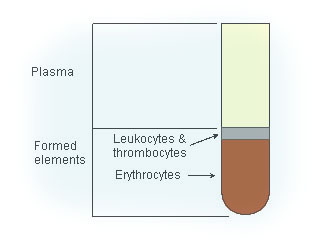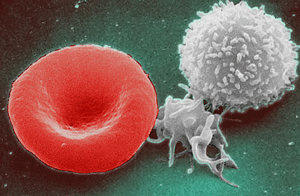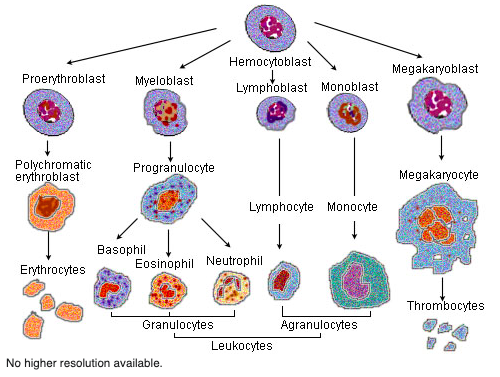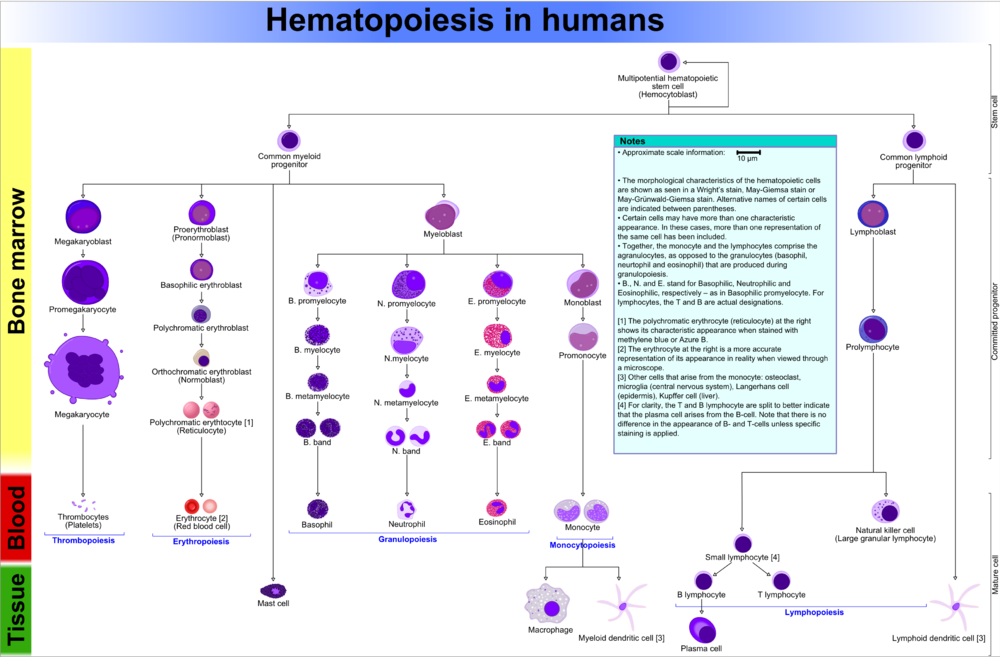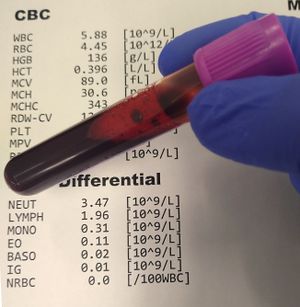Blood Physiology: Difference between revisions
No edit summary |
No edit summary |
||
| Line 86: | Line 86: | ||
* Iron Deficiency and [[Vitamin B12 Deficiency|vitamin B12]] Anemia | * Iron Deficiency and [[Vitamin B12 Deficiency|vitamin B12]] Anemia | ||
* Leucocytosis | * Leucocytosis | ||
* Leucopenia | * Leucopenia<ref>Illinois cancer care [https://illinoiscancercare.com/blood-disorders/blood-disorder-types/ Blood disorders] Available from:https://illinoiscancercare.com/blood-disorders/blood-disorder-types/ (last accessed 11.7.2020)</ref> | ||
== Final Remarks == | == Final Remarks == | ||
Revision as of 00:52, 11 July 2020
This article or area is currently under construction and may only be partially complete. Please come back soon to see the finished work! (11/07/2020)
Original Editor - User Name
Top Contributors - Lucinda hampton, Mandy Roscher, Kim Jackson, Tony Lowe, Tarina van der Stockt, Stacy Schiurring, Vidya Acharya, Rucha Gadgil, Jess Bell and Olajumoke Ogunleye
Introduction[edit | edit source]
Blood is a fluid connective tissue critical for:
- Transportation of nutrients, gases, and wastes throughout the body;
- Defence for the body against infection and other threats eg seek out and destroy internal threats, such as cells with mutated DNA that could multiply to become cancerous.
- Homeostatic regulation of pH, temperature, and other internal conditions.
Blood is composed of:
- Formed elements—erythrocytes, leukocytes, and cell fragments called platelets
- Fluid extracellular matrix called plasma. More than 90 percent of plasma is water, the remainder is mostly plasma proteins (mainly albumin, globulins, and fibrinogen) and other dissolved solutes such as glucose, lipids, electrolytes, and dissolved gases.
Because of the formed elements and the plasma proteins and other solutes, blood is sticky and more viscous than water. It is also slightly alkaline, and its temperature is slightly higher than normal body temperature[1].
Formed Elements[edit | edit source]
Image, from L to R: Blood cells - erythrocyte, thrombocyte, leukocyte.
Erythrocytes (red blood cells) - function primarily to ferry oxygen in blood to all cells of the body.
Salient Points
- Anucleate. RBCs differ from other blood cells because they are anucleate, that is, they lack a nucleus; they also contain a very few organelles.
- Hemoglobin (an iron bearing protein), transports the bulk of oxygen that is carried in the blood.
- Microscopic appearance - Erythrocytes are small, flexible cells shaped like biconcave discs- flattened discs with depressed centers on both sides; they look like miniature doughnuts when viewed with a microscope.
- Number of RBCs - normally about 5 million cells per cubic millimeter of blood; RBCs outnumber WBCs by approx. 1000 to 1, major factor contributing to blood viscosity.
- Normal blood - Clinically, normal blood contains 12-18 grams of hemoglobin per 100 milliliters (ml); the hemoglobin content is slightly higher in men (13-18 g/dl) than in women (12-16 g/dl).
Leukocytes
Salient Points
- Far less numerous than red blood cells and are crucial to body defense against disease.
- Number of WBCs. On average, there are 4,000 to 11,000 WBC/mm3 , and they account for less than 1 percent of total body volume.
- Body defense - form a protective, movable army that helps defend the body against damage by bacteria, viruses, parasites, and tumor cells.
- Diapedesis - a name for the process were white blood cells are able to slip into and out of the blood vessels.
- Positive chemotaxis - WBCs can locate areas of tissue damage and infection in the body by responding to certain chemicals that diffuse from the damaged cells (this capability is called positive chemotaxis).
- Ameboid motion. Once they have “caught the scent”, the WBCs move through the tissue spaces by ameboid motion (they form flowing cytoplasmic extensions that help move them along).
- Leukocytosis. A total WBC count above 11, 000 cells/mm3 is referred to as leukocytosis.
- Leukopenia. The opposite condition, leukopenia, is an abnormally low WBC count.
Many types of WBC's (see for more information Immune System)
- Granulocytes.
- Neutrophils.
- Eosinophils.
- Basophils.
- Agranulocytes. .
- Lymphocytes.
- Monocytes.
- Platelets. Platelets are not cells in the strict sense; they are fragments of bizarre multinucleate cells called megakaryocytes, which pinch off thousands of anucleate platelet “pieces” that quickly seal themselves off from surrounding fluids; platelets are needed for the clotting process that occurs in plasma when blood vessels are ruptured or broken[2].
Hematopoiesis[edit | edit source]
Hematopoiesis (blood cell formation), occurs in red bone marrow ie myeloid tissue.
- Erythrocyte production and the formation of leukocytes and platelets is stimulated by hormones.
- Hemocystoblast. All the formed elements arise from a common type of stem cell, the hematocystoblast.
The hemocystoblast forms two types of descendants:
- Lymphoid stem cell, which produces lymphocytes
- Myeloid stem cell, which can produce all other classes of formed elements.
Formation of Red Blood Cells (entire developmental process from hemocystoblast to mature RBC takes 3 to 5 days).
- Anucleate - RBCs are unable to synthesize proteins, grow, or divide.
- Life span - RBCs become more rigid and begin to fragment, or fall apart, in 100 to 120 days.
- Lost RBCs - Replaced more or less continuously by the division of hemocystoblasts in the red bone marrow.
- Immature RBCs - Developing RBCs divide many times and then begin synthesizing huge amounts of hemoglobin.
- Reticulocyte - When enough hemoglobin has been accumulated, the nucleus and most organelles are ejected and the cell collapses inward; the resulting in young RBC (ie reticulocyte) because it still contains some rough endoplasmic reticulum (ER).
- Mature erythrocytes - Within 2 days of release, they have rejected the remaining ER and have become fully functioning erythrocytes.
- Erythropoietin. The rate of erythrocyte production is controlled by a hormone called erythropoetin; normally a small amount of erythropoeitin circulates in the blood at all times, and red blood cells are formed at a fairly constant rate.
- Control of RBC production. An important point to remember is that it is not the relative number of RBCS in the blood that controls RBC production; control is based on their ability to transport enough oxygen to meet the body’s demands.
Formation of White Blood Cells and Platelets
- Colony stimulating factors and interleukins. These colony stimulating factors and interleukins not only prompt red bone marrow to turn out leukocytes, but also marshal up an army of WBCs to ward off attacks by enhancing the ability of mature leukocytes to protect the body.
- Thrombopoeitin. The hormone thrombopoeitin accelerates the production of platelets, but little is known about how that process is regulated[2].
Blood Disorders[edit | edit source]
There are many conditions of or affecting the human hematologic system ie the biological system that includes plasma, platelets, leukocytes, and erythrocytes, the major components of blood and the bone marrow. This list is an example of disorders:
- Sickle Cell Anemia
- Anemia of Chronic Disease
- Acute Lymphoblastic Leukemia
- Acute Myeloid Leukemia
- Multiple Myeloma
- Aplastic Anemia
- Erythrocytosis
- Hemochromatosis
- Paraneoplastic Syndrome
- Hypercoagulable Disorder
- Iron Deficiency and vitamin B12 Anemia
- Leucocytosis
- Leucopenia[3]
Final Remarks[edit | edit source]
Blood is the fluid in our bodies that maintains life and our existence. We cannot survive without blood and since our blood supports all of our bodily functions, it is required to be in a healthy condition.
- Red blood cells live for around four months and then they break down and parts are reused to make new blood cells.
- White blood cells in the body are like ‘defenders’ They fight off anything foreign, like a splinter, as well as against any germs that enter our system. For every one milliliter of blood there are around 5,000-7,000 white blood cells.
- When you are sick, your body increases the production of white blood cells to fight off infection. They can get as high as 25,000 for every one ml of blood.
- Blood carries all of the substances that we need to give us energy.Blood also carries natural hormones, such as insulin, from the pancreas as well as growth hormones from the brain[4].
References[edit | edit source]
- ↑ opentext ANATOMY AND PHYSIOLOGY Available from:https://opentextbc.ca/anatomyandphysiology/chapter/an-overview-of-blood/ (last accessed 5.7.2020)
- ↑ 2.0 2.1 Nurse lab Blood Available from:https://nurseslabs.com/blood-anatomy-physiology/ (last accessed 5.7.2020)
- ↑ Illinois cancer care Blood disorders Available from:https://illinoiscancercare.com/blood-disorders/blood-disorder-types/ (last accessed 11.7.2020)
- ↑ Science for kids Blood Available from:https://www.scienceforkidsclub.com/blood-facts.html (last accessed 11.7.2020)
